► Steer-by-wire tech
► Uses a butterfly-shaped yoke
► Debuting on RZ450e and bZ4X
Tesla has a reputation for packing bleeding-edge tech into its cars with mixed results, but its yoke steering system has to be classed as a misstep. Resembling something between light aircraft controls and a racing wheel you’d use on a gaming console, the yoke made its debut on the recent Model S refresh to a confused reception.
The idea is stubbornly simple: the car should be driving itself most of the time, so the driver doesn’t need a whole steering wheel taking up valuable cabin space. It’s the sort of binary Silicon Valley thinking that gave us the iPhone but also led Apple to remove USB ports from its high-end MacBooks – only to return them to service a few years later.
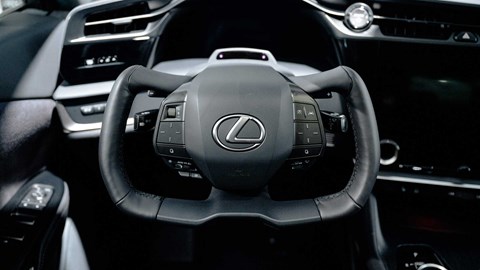
There is another yoke system doing the rounds now – and it hails from neither Germany nor America, but the ultra-conversative Toyota group. Surprised? You’d be even more surprised if we told you that it works – and well. The Lexus yoke is a viable step forward for EVs and other vehicles. How do we know? We tried it on a prototype of the new Lexus RZ450e.
Although yet another premium electric crossover on the outside, the Lexus RZ450e’s by-the-numbers exterior masks a radical interior innovation. The moment you step into the cabin, you can’t fail to spot One Motion Grip, and although it looks a lot like Tesla’s most recent attempt at the future of steering, here it’s backed by all-new technology.
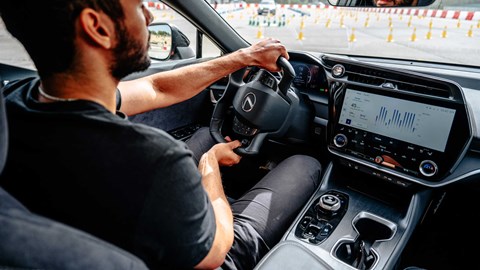
What is the One Motion Grip?
One Motion Grip consists of two key pieces of tech, but one is much more obvious than the other. Like Tesla, the Lexus uses a yoke-shaped butterfly design wheel, designed in part to improve passenger ingress and egress – and give a clearer view of the instrument dials ahead. Its similarity to Tesla’s system makes it look like a gimmick, but it’s very different in practice.
Tesla’s yoke is plugged into a conventional steering system, but in the Lexus it’s the most visible part of a system that that relies on software, sensors and a torque motor to communicate between driver and machine. That’s right: there is no physical steering column whatsoever and that’s a major innovation. It’s 100% steer-by-wire.
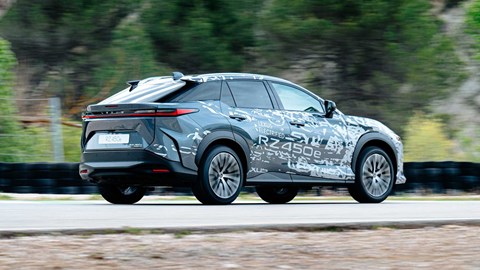
The One Motion Grip only requires 150 degrees lock-to-lock, and it’s nothing like using a standard wheel. ‘Being able to go lock-to-lock without doing hand-over-hand was the first condition before we even thought about implementing a yoke,’ Lexus chief engineer Takashi Watanabe told CAR magazine. ‘You need a round steering wheel because you’re doing hand-over-hand. You need to grab it at any point, but when you don’t, that’s the first time you can consider using a yoke.’
Cleverly, Lexus is making the yoke optional. You can choose a conventional round wheel and physical steering system, or the yoke and steer-by-wire. It’s a binary choice and you can’t order a rotund wheel with the digital steering – nor can you spec a yoke on the end of a physical rack. We think that’s for the best.
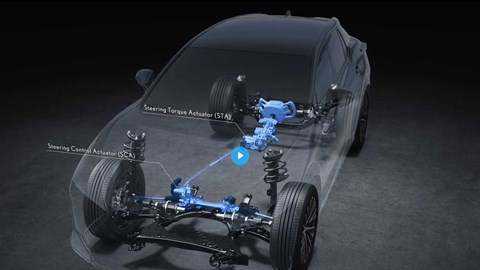
So how does steer-by-wire work?
Rather than a physical connection, the Lexus uses a mixture of sensors and actuators to record and process the driver’s inputs – as well as information about the road surface. Data from the steering wheel is captured and sent to a steering actuator, and feedback is zapped back to the wheel via a torque motor.
As you’d expect, there’s a significant amount of redundancy in the system, and that – combined with the torque motor – means the steer-by-wire system is heavier than the standard one.
‘We had to add a feedback motor onto that, and we also have a back-up system, an emergency power pack that we added,’ Watanabe says. ‘So it’s a 10kg addition.’
What’s it like on the road?
After a few laps guiding the Lexus through cones and the ParcMotor circuit, I jump out of the car to a huddle of Lexus engineers, each with a notepad and air of expectation. ‘What do you think?’ is the question I’m dreading, and it’s naturally one they ask. One Motion Grip is unlike anything I’ve used before, and it’s hard to formulate my experience into useful feedback.
It’s both intuitive and deeply alien. The quarter-to-three hand position becomes natural after a while, as does the quick lock – but the main difference is the type of feedback I’m getting from the wheel. It doesn’t feel disconnected, but it’s certainly filtered.

I’m not surprised when Lexus engineers reveal the PlayStation generation is better at adapting to the new steer-by-wire system – because using the One Motion Grip is a lot like playing a racing game. But not a top-of-the-range Fanatec one you’d play GT7 with – one with way less force-feedback. It turns out, that’s intentional.
‘We can control what kind of feedback comes back from the road; we can mask some and let some pass through,’ Watanabe tells me later. ‘The RZ450e is more of an everyday vehicle. We’ve found the best balance for that sort of car.’ Motoring journalist hat firmly on the dash for a minute, and the all-electric Lexus provides all the feedback you’d want for a trip to the shops.
The future of steer-by-wire
Performance EVs will likely have far grainier feedback, and a torquier steering response. In something like an electric Lexus LFA I’d want a lot more, and the engineers are already on the case: ‘If we want to go way towards a sports car on the spectrum like in track conditions, we can put on a circuit mode,’ adds Watanabe. ‘The motors can give much more torque and feedback: we can create something like that easily.’
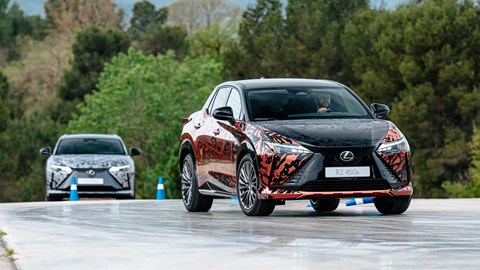
What to make of it?
It’ll take a while to get used to steer-by-wire and yokes – I even needed longer on the slow-speed stuff – but it does feel like a step forward in how we control cars. Bladerunner-form aside, it’s crucially easier and more efficient than conventional steering. What’s more it also complements the relaxed, effortless power delivery of an EV. One small issue: Because wheel controls move with your hands they have to be a bit smaller, and I often missed the stubby indicators.
‘If you have such an improvement in torque response,’ explains Watanabe, ‘then the steering response has to improve at the same rate to keep up with that.’ Tesla tried, but it feels like Lexus’s more joined-up system has done just that.
The only issue? How Lexus sells it to prospective buyers: a standard test drive is too short to get properly acclimatised to the new system.
Would you order a yoke instead of a steering wheel? Be sure to sound off in the comments below.